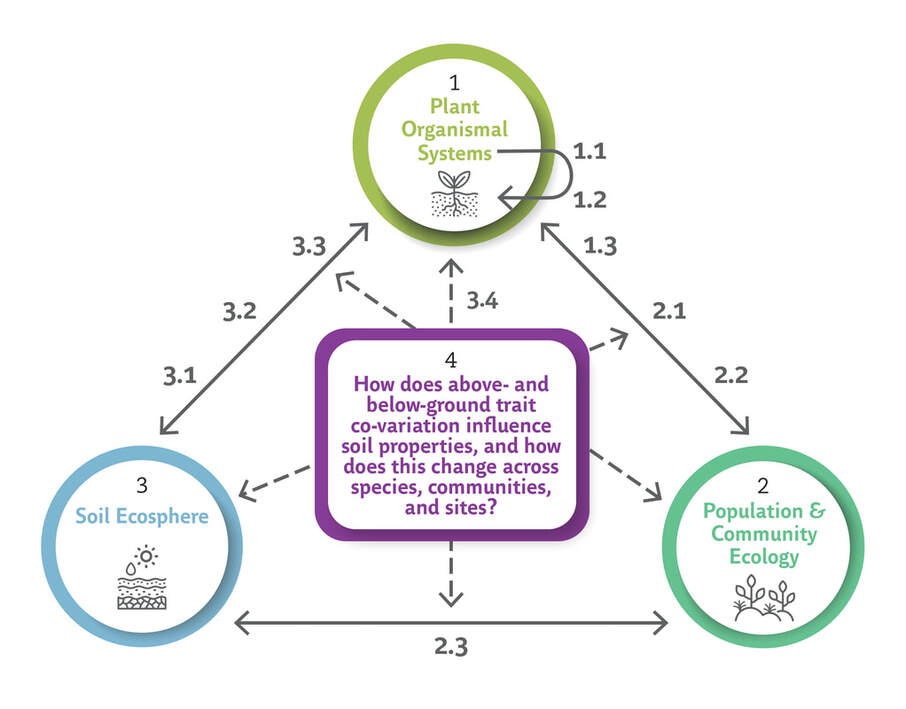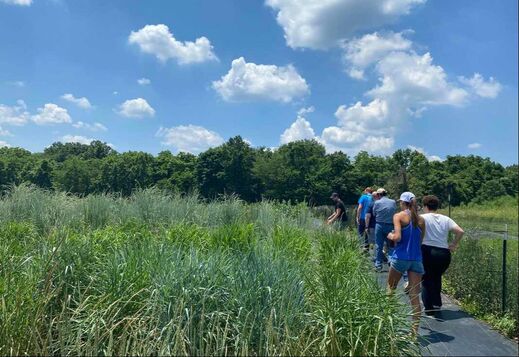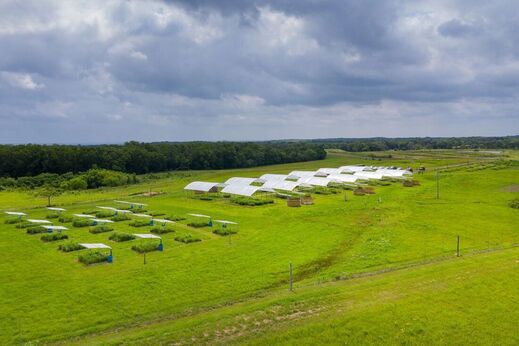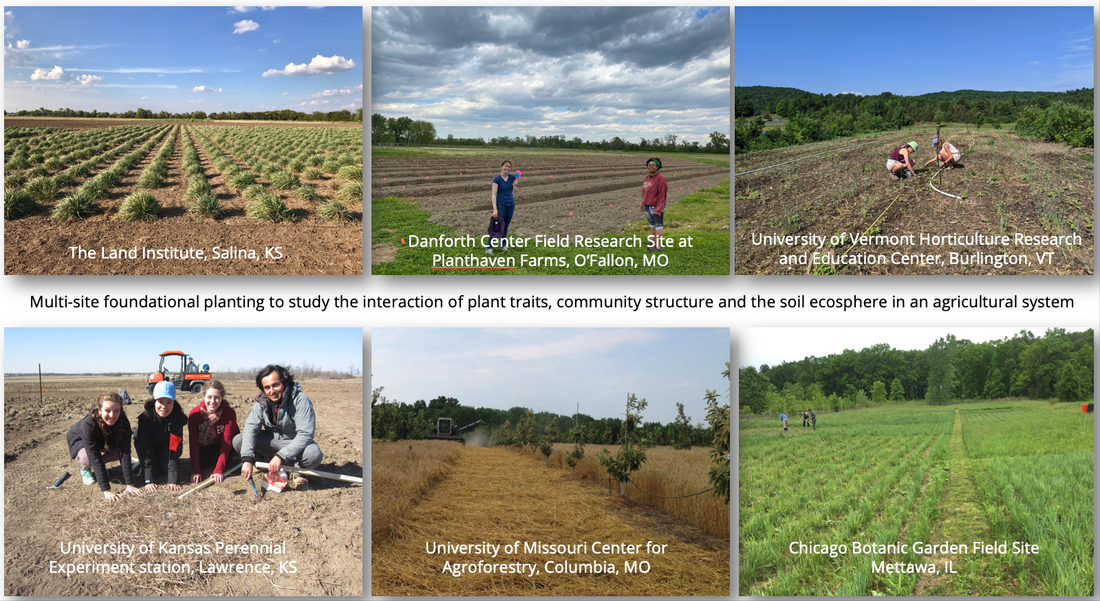Integrating Plant Organismal Systems, Population & Community Ecology, and the Soil Ecosphere
The New Roots for Restoration Biology Integration Institute aims to advance the critical, cross-cutting biological theme of how plant roots and shoots relate to one another, and how these relationships influence and are influenced by plant communities and the soil ecosphere. We envision a series of concentric circles that orient and guide the coordinated activities of the Institute. At the core are plant organismal systems, in which we apply contemporary phenotyping approaches and develop new methods to quantify plant root and shoot systems and ask how above- and belowground plant traits covary at the individual, population, and species levels. Next, we place plants in population and community contexts and investigate how patterns of above- and belowground trait covariation shift across populations and change as a function of community composition. To understand interactions between plants, communities, and the soil ecosphere, we design new experiments to examine how soil and soil microbiome (soil ecosphere) mediates root/shoot variation and interactions of populations and plant species, and vice versa. In a final synthetic goal, we use structural equation modeling (SEM) to assess the relative importance of plant phenotypic variation, species, communities, and site properties to changes in soil.
Institute Research Projects
|
The New Roots for Restoration Institute aims to advance the critical, cross-cutting biological theme of how plant roots and shoots relate to one another, and how those relationships influence and are influenced by plant communities and the soil ecosphere. We envision a series of concentric circles that orient and guide the coordinated activities of the Institute. At the core are plant organismal systems, in which we apply contemporary phenotyping approaches and develop new ones to quantify plant root and shoot systems and ask how above- and belowground plant traits covary at the individual, population, and species levels. Next, we place plants in population and community contexts and investigate how patterns of above- and belowground trait covariation shift across populations and change as a function of community composition. To understand interactions between plants, communities, and the soil ecosphere, we design new experiments to examine how soil and soil microbiome (soil ecosphere) mediates root/shoot variation and interactions of populations and plant species, and vice versa. In a final synthetic goal, we use structural equation modeling (SEM) to assess the relative importance of plant phenotypic variation, species, communities, and site properties to changes in soil.
|
Goal 1: How do root and shoot traits covary? Plant Organismal Systems.
- Project 1.1 Is covariation between shoot (aboveground) traits and root (belowground) traits consistent across species? We will leverage an existing experiment at Gray Summit, MO to quantify above- and belowground trait covariation in 11 perennial, herbaceous species and develop a new iPhone-based app for digital aboveground phenotyping.
- Project 1.2 What is the genetic basis of root/shoot covariation? With seed derived from Project 1.1, we will establish genome-wide association study (GWAS) populations in two contrasting sites (natural vs. agricultural) near St. Louis, MO. Root growth data will be quantified in real time with a new in-field root phenotyping approach paired with shoot phenotyping and genetic data.
- Project 1.3 How is (co)variation in root and shoot traits distributed among populations within species? Researchers at the Chicago Botanic Garden will collect wild populations of three species used in Project 1.1, 1.2, or 2.1. Trait data will be collected on multiple lines of micropropagated plants to assess variation at each organizational level (clone, population, species).
Goal 2: Does above- and belowground trait variation predict, and respond to, plant community composition? Population and Community Ecology.
- Project 2.1 Can above- and belowground phenotypic variation predict coexistence, diversity, and community productivity? An existing NSF Dimensions of Biodiversity experiment in Lawrence, KS, houses communities of 1, 2, 3, or 6 of 18 perennial, herbaceous species representing our three focal plant families. We will collect root and shoot trait data to link plant traits with community-level properties.
- Project 2.2 How does intraspecific variation in above- and belowground traits modulate interspecific competitive relationships and biodiversity-ecosystem function (BEF) relationships? Building on Project 1.3, we will quantify how intraspecific functional trait variation influences interspecific interactions in experimental polycultures.
- Project 2.3 Do root/shoot plant traits vary in monocultures vs. polycultures of perennial herbaceous species, and does this predict production? Does this change with the addition of a tree species? Moving from natural to agricultural systems, we will establish a foundational multi-site experiment with emerging perennial crops planted in mono- and polycultures across precipitation and latitudinal gradients. Comprehensive above- and belowground phenotyping will be conducted over multiple years.
Goal 3: Do soil and the soil microbiome mediate root/shoot variation and covariation and population/species level interactions? Soil Ecosphere.
- Project 3.1 How does soil type influence root/shoot variation and covariation? We will collect data on soil physicochemical properties for Projects 1.2, 2.2, and 2.3.
- Project 3.2 Does variation in root/shoot traits within wild plant species predictably shape root microbiomes? Analyses of rhizosphere microbes of Project 1.1 plants will determine host-specific effects on microbiome diversity and composition.
- Project 3.3 How do soil/root microbiomes, including those sensitive to plant community diversity, impact host above- and belowground traits? Inocula from Dimensions of Biodiversity plots (Project 2.1) will be used in greenhouse experiments to assess root and shoot trait responses to plant community diversity effects on microbiomes.
- Project 3.4 How do monocultures and polycultures of perennial crops impact soil abiotic properties and soil community structure? How do soil communities differentiated by crop identity and diversity influence crop root/shoot traits? We will quantify soil structure and composition data and microbial diversity in replicated mono- and polyculture crop plots at the beginning and end of Project 2.3. Inocula from mono- and polyculture plots in Project 2.3 will be used in greenhouse experiments to assess root and shoot trait responses of crops to cropping treatments.
Goal 4: How does the effect of above- and belowground trait covariation on soil properties change among plant species, communities, and sites? Synthesis and Integration. Structural equation modeling (SEM) will be used to assess the relative importance of species, communities, and site properties to soil properties in replicated perennial cropping communities (Projects 2.3, 3.4). These tools can delineate direct effects of plant intercropping on soil from indirect effects through shifts in root and shoot traits of individual species.
Institute Field Sites
Proposed projects leverage existing experiments near DDPSC and in Kansas. New experiments will take place in greenhouses and field sites at or near The Land Institute (Salina, KS), University of Kansas (Lawrence, KS), University of Missouri (Columbia, MO), DDPSC, Chicago Botanic Garden (Glencoe, IL), and University of Vermont (Burlington, VT).




